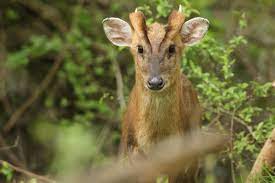In the enchanting realm of the animal kingdom, where creatures of all shapes and sizes reside, one particular group stands out for its captivating beauty and diminutive stature – the miniature deer. These tiny yet majestic creatures are a testament to the diverse and wondrous world of wildlife. In this blog, we will delve into the fascinating world of miniature deer, exploring their unique characteristics, habitat, behavior, and the efforts taken to ensure their conservation.

I. Understanding Miniature Deer: The term “miniature deer” collectively refers to several small deer species, each unique in its own way. Some of the well-known miniature deer species include the Southern Pudu, Northern Pudu, Java Mouse-Deer, and Visayan Spotted Deer. These small deer have captured the attention and admiration of wildlife enthusiasts worldwide due to their adorable size and graceful appearance.
II. Physical Characteristics: Miniature deer are characterized by their small size, with adults typically weighing no more than 50 pounds. They have slender bodies and graceful legs, which allow them to navigate through dense vegetation with ease. Their fur varies in color, ranging from shades of brown to reddish or gray, often featuring intricate patterns that help them blend into their natural surroundings.
III. Habitat and Distribution: Miniature deer are native to different regions across the globe. For instance, the Southern Pudu is found in the temperate rainforests of Chile and Argentina, while the Northern Pudu inhabits the cloud forests of Colombia, Ecuador, and Peru. The Java Mouse-Deer, as the name suggests, is native to the Indonesian island of Java, and the Visayan Spotted Deer is found in the Philippines.
IV. Behavior and Adaptations: Miniature deer have developed a range of adaptations to survive in their respective habitats. Due to their diminutive size, they are highly elusive and skilled at hiding from predators. They are primarily crepuscular or nocturnal, meaning they are most active during dawn and dusk or at night, which helps them avoid potential threats.
V. Diet and Feeding Habits: Miniature deer are herbivores and primarily feed on a diet of leaves, fruits, and other plant materials. Due to their small size, they need to consume a significant portion of their body weight in food each day to meet their energy requirements.
VI. Reproduction and Parenting: Miniature deer typically have short gestation periods, with females giving birth to one or two offspring at a time. Newborns are often precocial, meaning they are relatively independent and capable of moving and feeding shortly after birth. Mothers provide care and protection to their young until they are old enough to fend for themselves.
VII. Conservation Status and Challenges: Despite their captivating charm, miniature deer face various conservation challenges. Loss of habitat due to deforestation, illegal hunting, and predation by introduced species are some of the significant threats these deer species encounter. As a result, several miniature deer species are classified as vulnerable or endangered by the International Union for Conservation of Nature (IUCN).
VIII. Conservation Efforts: Conservation organizations and local communities have taken significant steps to protect and conserve miniature deer species. Initiatives include establishing protected areas, implementing anti-poaching measures, and raising awareness about the importance of preserving these charming creatures and their natural habitats.
Conclusion: The world of miniature deer is a testament to the incredible diversity and wonder of the animal kingdom. These tiny yet enchanting creatures serve as a reminder of the delicate balance of nature and the importance of preserving biodiversity. By supporting conservation efforts and respecting the habitats of miniature deer, we can contribute to ensuring that these graceful creatures continue to thrive in the wild for generations to come.



















Add Comment